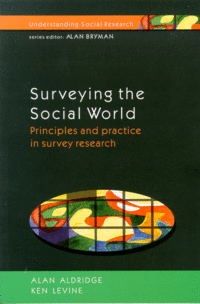

![]()
![]()

With the accessibility of a self-help guide this book provides a basic breakdown of what is required in survey research and the likely pitfalls. The authors claim, quite rightly, that many social survey texts fall down because they do not differentiate realistically between what is feasible for a small scale or solo project and a research centre commanding a whole team of researchers.(p.xi) Here, however, in the chapter 'Planning your project' one is provided with clear practical examples of likely costs of even such minor factors as transcribing. The authors assume no previous knowledge of doing research and no practical point is too insignificant, down to the advantages of foot manipulated tape recorders. Also covered is how to establish the potential originality of the research, timetabling, and various methods of data collection (with an emphasis on combining methods), along with outlining the various types of software available.
The chapters on sampling and data collection are excellent. The sampling chapter while providing a definition of what it is and when it is required, also shows how it should be integrated with theoretical considerations. Above all the authors are consistently realistic, emphasising that 'the most sophisticated sample design represents no more than an attempt to reach a rational compromise between rigour on the one hand and an effective application of time and money on the other.'(p.62) The chapter 'Collecting your data' continues with this 'down to earth' style, stressing the advantages of collecting one's own data rather than using hired interviewers, emphasising that it gives one a better 'feel' for the research. Drawing on Saunders (1990) they argue 'Doing it yourself is deeply satisfying. It is also more conducive to the exercise of the sociological imagination.'(p.85) There is also sensible advice on how interviewing methods can hinder or help the research, and useful information on laying out covering letters for postal questionnaires.
The chapter on designing questionnaires continues with more practical guidelines entertainingly covered. It focuses on the importance of the 'sociological imagination' and throughout tries to keep the authors' overriding aims to the fore: 'to frame questions that are meaningful, sensitive, precise, searching and salient to our respondents [so that they] will want them to answer them as fully as possible.'(p.95) Advice is also offered on helping readers avoid the minefield inherent in questionnaire design, especially concerning sensitivity towards the respondents: 'Our respondents are informants with their own individual points of view'.(p.101) With this in mind the potential negative effects certain use of language are also covered. Two other useful sections in this chapter are those dealing with the main things that go wrong and the most frequently asked questions.
The final two chapters deal with 'Strategies for analysis' and 'Presenting the findings'. The first of these is necessarily more complex but it still maintains the clarity that has existed elsewhere in the text. It's main focus is helping the inexperienced surveyor 'avoid the danger of getting trapped in a mass of data and losing the plot. Ultimately the authors argue that 'imaginative analysis of survey data necessarily transcends statistical reasoning.'(p.136) To finish off, the writing up chapter nicely establishes the conflict between academic and practical research needs with some amusing examples before going on to provide a clear simple outline of the 'classic report'. The authors juxtapose a UK funding council's research introduction, 'a structuralist informed challenge to both positivistic and humanistic/post-structuralist approaches…' to certain reactions from business, 'If I can't get to the point of the report quickly enough, it goes in the bin' and 'I've got on my desk now a very important piece of research—I think'.(pp.161-2)
Overall, I found this book the most readable and entertaining text on social research methods since O'Connell, Davidson and Layder's excellent Methods, Sex and Madness. With its in-depth discussions on research techniques coupled with its 'down to earth' advice, I believe this text should be on the 'essential' reading list of all introductory social research methods courses, not to mention on the bookshelves of anyone who engages in social surveys.
Stephen Brindle
University of Aberdeen
SAUNDERS, P. 1990. A Nation of Home Owners. London: Unwin Hyman.